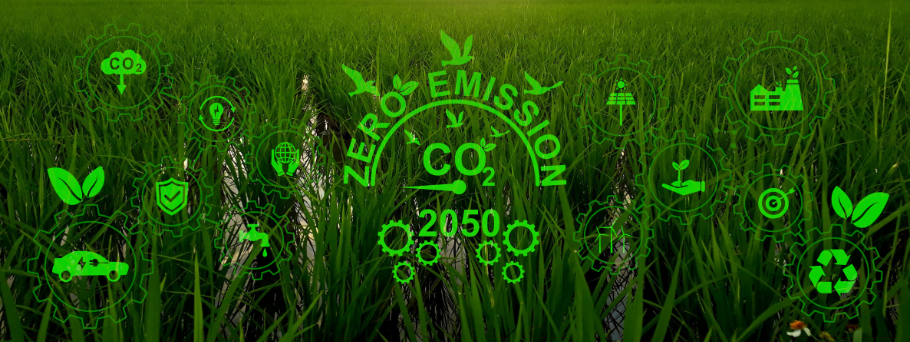
Reducing greenhouse gas emissions is key in gaining net zero and preventing catastrophic climate change. As a result, governments around the world agreed to try to reach net zero by 2050 as part of the Paris Agreement.
Let’s find out what net zero is and how to achieve it in this article.
What is Net Zero?
Net Zero, or “Net Zero Emissions”, is an environmental goal that aims to reduce human-caused greenhouse gas emissions (such as CO2, CH4, N2O) to a level that is balanced with the Earth’s ability to absorb or remove emissions, to the point where the total net emissions are reduced to zero.
This requires reducing emissions from sources such as transportation, industrial production and power generation. Also, it needs increasing carbon sequestration through measures such as forest conservation and carbon capture and storage (CCS) technologies.
The goal of achieving net zero emissions aims to mitigate the impact of climate change under the Paris Agreement, with the hope of keeping global temperature rise below 2°C and efforts to limit warming to below 1.5°C above pre-industrial levels.
To achieve this, both governments, businesses, and individuals need to commit to reducing emissions and supporting solutions for carbon sequestration. Therefore, we can create a less carbon and more sustainable global economy.
The Importance of Net Zero
Science clearly shows that in order to prevent the worst effects of climate change, global temperature rise needs to be limited to 1.5°C above pre-industrial levels.
Currently, the Earth is about 1.1°C warmer than it was in the late 1800s, and emissions continue to rise. To keep global warming at no more than 1.5°C – as required in the Paris Agreement – emissions need to be reduced by 45% by 2030 and reach zero by 2050.
Most countries have only recently started implementing net zero goals and policies. However, these strategies still have tremendous significance and impact, benefiting the environment and communities around the world.
1. Enhancing Food Security
Plants grow better in climates suitable for them, so a rapid rise in global temperatures is dangerous. Net zero policies will be more sustainable for the environment, contributing to improved crop health and higher agricultural output.
2. Protecting Ocean Health
In fact, elevated amounts of atmospheric CO2 raise temperatures enough to harm marine life through impacts such as ocean acidification and changing ocean currents, which will accelerate sea level rise.
The severe impact on carbon sequestration into the oceans and coral reefs could be reduced by up to 50% even if global warming eases slightly.

3. Generating a Better Life
Fewer emissions mean less polluted air, which will lead to better life. Since about 7 million people die from air pollution each year, reducing pollution is important.
4. Limiting Climate Change
Weather phenomena such as floods, droughts, global warming, and biodiversity decline are very common side effects of climate change.
Reducing greenhouse gas emissions will positively contribute to the improvement of weather patterns. Thus it helps reduce the scale, duration, and intensity of such catastrophic events.
5. Promoting Economic Development
Obviously, the transition to a net zero economy opens up many new development opportunities for renewable energy, green technology, and energy efficiency industries.
It helps create new jobs, promote economic growth and improve people’s lives.
How to Achieve Net Zero?
Transitioning to a net zero world is one of the biggest challenges facing humanity. This means a complete transformation in the way of production, consumption, and movement, etc.
The energy sector accounts for three-quarters of today’s greenhouse gas emissions. So, it plays a key role in preventing the devastating effects of climate change.
1. Reducing Emissions from the Beginning
The IPCC has put forward more than 200 roadmaps to reduce carbon emissions to achieve the Net Zero goal. Short, medium, and long-term targets for carbon reduction vary from roadmap to each roadmap.
However, businesses should focus and choose to significantly reduce carbon emissions in the short term instead of increasing efforts at a later stage.
Furthermore, the IPCC has calculated carbon reduction scenarios based on current environmental conditions.
Therefore, if the future climate change situation causes problems such as forest fires, ocean acidification and other factors that deplete carbon sinks, the lack of appropriate carbon reduction measures will lead to risks in the early stages.
This can cause a loss of flexibility in responding to these situations.

2. Comprehensive Emissions Reduction
In contrast to net zero, the difference of carbon neutrality is a comprehensive assessment of greenhouse gas emissions.
Therefore, actions to achieve this goal are limited to increasing the use of clean energy. Beside that, actions include measures such as control of improved motor technology, waste disposal and all behaviors that can generate greenhouse gas emissions.
This requires a concerted effort by all sectors, including those that struggle to reduce carbon emissions, such as heavy industry, architecture, agriculture, aviation, and mining.
Therefore, low-carbon emitting industries initially need to take other actions besides reducing their own carbon footprint.
3. Caution in Removing Carbon Dioxide to Gain Net Zero
Although investment and research on direct carbon capture and storage in the air (DACCS) technology is ongoing, we need to remember that the long-term impact of this on the environment remains uncertain.
The concerns arising from sending large amounts of CO2 into the environment and the potential risks of afforestation also need to be considered, especially when they can be easily affected by natural disaster events such as floods or fires.
Therefore, in the process of dealing with climate change, reducing carbon emissions from sources remains a top priority.
And, measures to remove CO2 should be taken carefully, and only when the world has entered a phase where reducing carbon emissions is no longer feasible.
4. Effective Regulation of Carbon Offsets
Right now, companies can get carbon credits from many different groups. These groups all have their own ways of figuring out how many credits a company deserves, and their programs can be quite different.
The problem is, there’s no one agreed-upon way to track and measure carbon reduction. This can lead to a few issues:
- Plans to reduce carbon might not be well-designed from the start.
- The plans might not consider all the ways they could affect the environment outside the company.
- Some companies might end up getting more credits than they actually deserve.
Therefore, governments and standards verification organizations need to propose comprehensive assessment methods.
For businesses, careful research on each carbon offset program is necessary to ensure that the money spent on the purchase of carbon credits is used effectively, while investing in climate measures that bring positive impacts.
5. Equitable Transition to Net Zero
The transition from industrial production to the net zero model has become a challenge for developed countries. However, because each country has its own context and conditions, achieving the net zero goal cannot be applied uniformly.
This requires flexibility in designing transformation pathways tailored to the specific conditions of each country.
Additionally, investing in developing countries can be an effective way to reduce inequalities in dealing with climate change.
By supporting them in adopting clean technologies and developing renewable energy sources, it will help reduce global emissions. In addition, it can also create sustainable development opportunities for countries with developing economies.
6. Restoration of the Ecosystem
Today, climate change is a top priority to be addressed, but environmental and social aspects also need to be considered to mitigate global warming.
Of course, the restoration of the original ecosystem should also be prioritized to avoid problems that arise from reducing carbon emissions.

7. Promote the Transformation towards Net Zero of Large Enterprises
Some argue that the net zero goal could have a negative impact on the national economy and the profitability of businesses. In fact, achieving it requires large investments and a challenging transition.
But for the whole country, there’s a good reason to cut subsidies for dirty industries, include:
- Less money going to polluters like oil and gas companies means more money can be invested in cleaner options.
- This could be things like solar panels, wind turbines, and ways to store energy.
- By doing this, the country can create a new economic model that’s both cleaner and more valuable.
On the other hand, if corporations are able to take the lead in reducing their carbon footprint, they will have a competitive advantage over their competitors, while attracting the interest of consumers, investment capital, and talent.
Conclusion
In short, to achieve the net zero goal, it is necessary to quickly and comprehensively transform the energy, industry, and consumption systems, combine forest protection, international cooperation, and jointly raise awareness and develop science and technology to achieve Net Zero 2050, building a sustainable future for ourselves and future generations.


